Changing tax class with a change in life situation can put a lot of money in your pocket.
Key takeaways
- You can change tax classes offline or online via Elster. In both cases, you need to submit a tax class change application.
- You can also use the services of the tax advisor we recommend to handle your tax class change.
- You can change your tax classes multiple times in a year.
- A change in your marital status, health, or job status can trigger a tax class change.
- German government increased the basic tax-free allowance from 11,784€ (in 2024) to 12,096€ (in 2025).
- You can apply for a tax class change and get tax benefits retroactively.
Table of content
You have three ways to change your tax class in Germany.
- Submitting a paper form to your local tax office
- Applying online for tax class change on Elster
- Hire an English-speaking tax consultant to do it for you.
Submitting a paper form to your local tax office
From 1 Jan 2025, the form “Antrag auf Steuerklassenwechsel bei Ehegatten” is not used anymore. You must fill out the form “Antrag auf Lohnsteuer-Ermäßigung” instead. In this form, you fill in the appendix “Steuerklassenwechsel.”
- Download the form “Antrag auf Lohnsteuer-Ermäßigung” (Application for tax class change for married people).
- Print the form, fill it out, sign it, and post it to your local tax office (Finanzamt in German).
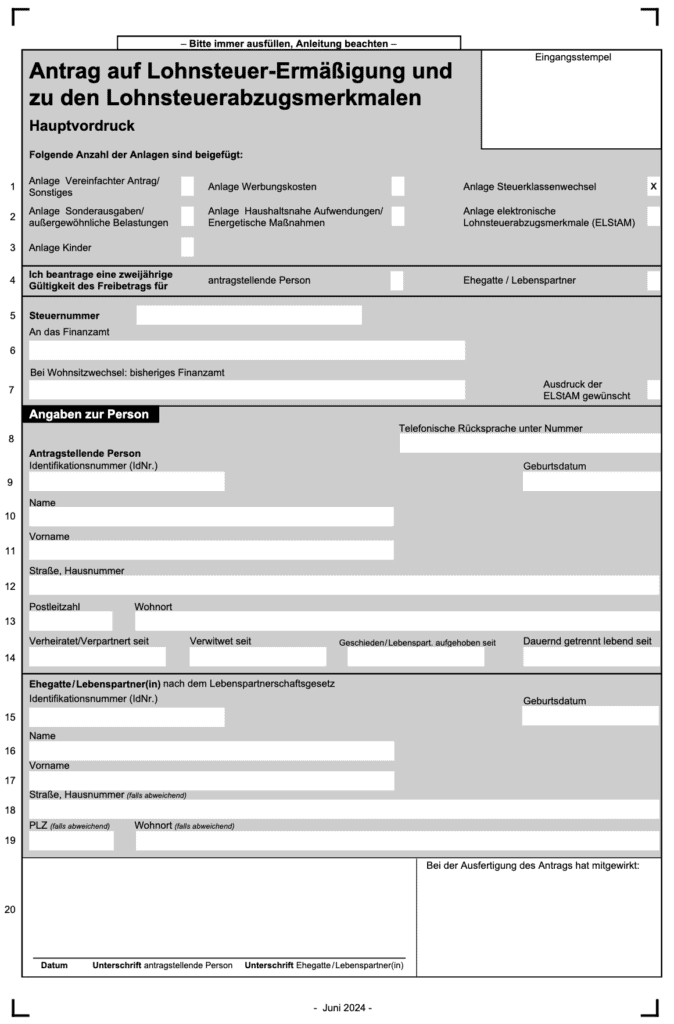
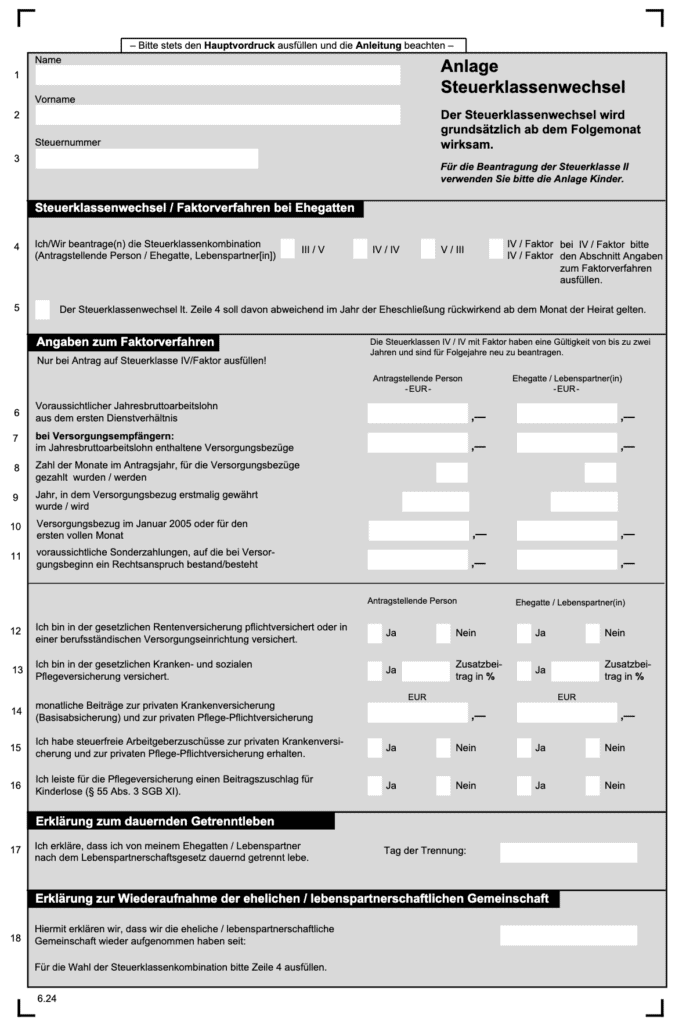
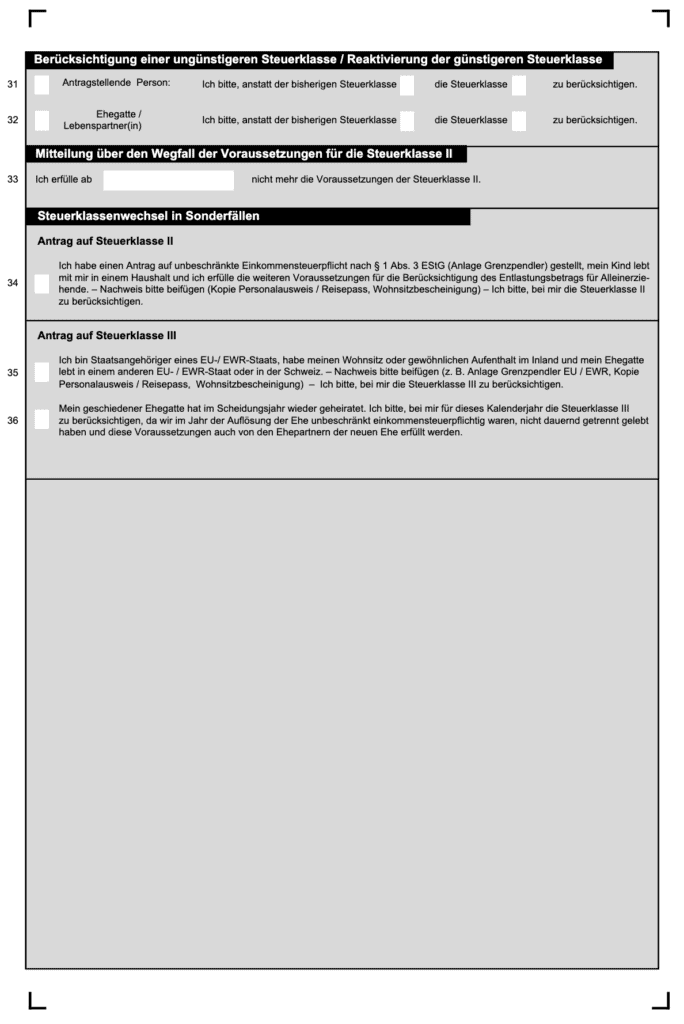
How do you fill out the tax class change application?
The tax change application is a small and simple form. Here are the descriptions of the fields in the tax change form.
Filling out the main form “Antrag auf Lohnsteuer-Ermäßigung.“
| Line Number | Field name | Description |
| 1 | Folgende Anzahl der Anlagen sind beigefügt: | Select “Anlage Steuerklassenwechsel” |
| 5 | Steuernummer | Your local tax office assigns you a tax number the first time you file an income tax. Thus, you won’t have a tax number if this is your first time filing an income tax return. Hence, fill in this field with your tax number if you have one; else, leave it empty. |
| 6 | An das Finanzamt | |
| 7 | Bei Wohnsitzwechsel: bisheriges Finanzamt | If you moved to a new city or district, mention the name of your last tax office in this field. |
| 8 to 14 | Angaben zur Person | Your personal details |
| 15 to 19 | Ehegatte/ Lebenspartner(in) nach dem Lebenspartnerschaftsgesetz | Personal details of your partner |
| 20 | Datum, Unterschrift | Date, and your and your partner’s signatures |
Filling out the appendix “Steuerklassenwechsel.“
| Line number | Field name | Description |
|---|---|---|
| 1 & 2 | Name, Vorname | Enter your last and first name |
| 3 | Steuernummer | Your local tax office assigns you a tax number the first time you file an income tax. Thus, you won’t have a tax number if this is your first time filing an income tax return. Hence, fill in this field with your tax number if you have one; else, leave it empty. |
| 4 | Wir beantragen die Steuerklassenkombination (Antragstellende Person/Ehegatte, Lebenspartner[in]) | Check the new tax class combination you want. Start with your tax class, followed by your spouse’s tax class. |
| 5 | Der Steuerklassenwechsel lt. Zeile 4 soll davon abweichend im Jahr der Eheschließung rückwirkend ab dem Monat der Heirat gelten. | By checking this box, you request that the tax office evaluate your tax retroactively since your wedding day. |
| 6 – 11 | Angaben zum Faktorverfahren | If you selected 4/4 with a factor in field 4, you must fill this section. Else, leave it empty. |
| 6 | Voraussichtlicher Jahresbruttoarbeitslohn aus dem ersten Dienstverhältnis | Write your and your partner’s estimated gross annual salary. |
| 7 | bei Versorgungsempfängern: im Jahresbruttoarbeitslohn enthaltene Versorgungsbezüge | If you are receiving a pension, mention the annual pension you get. |
| 8 | Zahl der Monate im Antragsjahr, für die Versorgungsbezüge gezahlt wurden/werden | If you are receiving a pension, mention how many months in the claim year you received the pension. |
| 9 | Jahr, in dem Versorgungsbezug erstmalig gewährt wurde/wird | The year in which your pension benefits started. |
| 12 | Ich bin in der gesetzlichen Rentenversicherung pflichtversichert oder in einer berufsständischen Versorgungseinrichtung versichert. | Tick the check box “Ja” (Yes), if you are part of statutory pension insurance or part of your employer’s pension insurance. Else tick “Nein” (No). Similarly, check the appropriate box for your spouse. |
| 13 | Ich bin in der gesetzlichen Kranken- und sozialen Pflegeversicherung versichert. | Tick the check box “Ja” (Yes) if you are part of public health insurance. Otherwise, leave this field empty. Also, mention your “Zusatzbeitrag.” You can ask your health insurance provider about the same or check it in your pay slip. Similarly, fill in the field for your spouse. |
| 14 | monatliche Beiträge zur privaten Krankenversicherung (Basisabsicherung) und zur privaten Pflege-Pflichtversicherung | If you are part of private health insurance, enter your monthly contribution to your private health insurance plan. Else, leave it empty. |
| 15 | Ich habe steuerfreie Arbeitgeberzuschüsse zur privaten Krankenversicherung und zur privaten Pflege-Pflichtversicherung erhalten. | Check the box “Ja” (yes) if you received tax-free subsidies from your employer for private health insurance. |
| 16 | Ich leiste für die Pflegeversicherung einen Beitragszuschlag für kinderlose (§ 55 Abs. 3 SGB XI). | Check the box “Ja” (Yes) If you don’t have kids but pay for long-term care insurance for children. |
| 17 | Erklärung zum dauernden Getrenntleben | Fill this section only if you are separated from your partner |
| 18 | Erklärung zur Wiederaufnahme der ehelichen / lebenspartnerschaftlichen Gemeinschaft | Fill this section if you resumed your marriage or civil partnership |
| 31 & 32 | Berücksichtigung einer ungünstigeren Steuerklasse / Reaktivierung der günstigeren Steuerklasse | Fill in this field if you want to prevent a change in the tax class (e.g., due to marriage) and stay in the previous or current tax class. |
| 33 to 36 | These fields need to be filled in special cases and are self-explanatory |
Few things you must know.
- When you get married, the tax office assigns you the tax class combination IV/IV automatically.
- The application for a change in tax class for spouses/life partners must generally be signed by both parties. An exception to this rule is that the signature of one spouse/life partner is sufficient if they are applying for a change from tax class III or V to tax class IV.
Applying online for tax class change on Elster
The German tax office prefers dealing with tax assessment, tax class change, and any other tax-related request digitally.
Elster is the official website of the German tax authorities. It offers many services like filing a tax return, applying for a tax class change, etc.
So, here are the steps to apply for a tax class change on Elster.
- Go to the following link.
- Select the year and click next. You will be forwarded to the “Log in” page.
- Log in using your Elster account. If you don’t have an Elster account yet, create one. Creating the account may take a few days as the tax office sends a code via post to complete the registration process.
- The application form is similar to the offline form. Only the sequence of questions is different.
- If you are applying for a tax class change by yourself, you can skip section, “Abweichender Absender des Antrags.” Your tax consultant will fill this section/page if they apply for a tax class change on your behalf.
- Complete the online application and submit it.
NOTE: The employer must account for the new tax class in the payroll beginning next month.
Hiring a tax advisor in Germany
You can also hire a tax advisor to handle your tax class change.
Finding a good tax consultant in Germany is tough. Moreover, finding someone who offers their service in English is rare.
We have done the heavy lifting for you. We have found one of the best tax advisors in Germany who offers their services in English.
You can book an appointment with them here.
Get a Free Quote From a Tax Advisor

- A tax advisor can help you file an income tax return,
- Change tax class,
- Get a tax residency certificate,
- Support in starting a business,
- Offer services in English
German tax classes (Steuerklassen in German)
There are seven different tax classes in Germany. Your payroll tax deduction depends on your tax class.
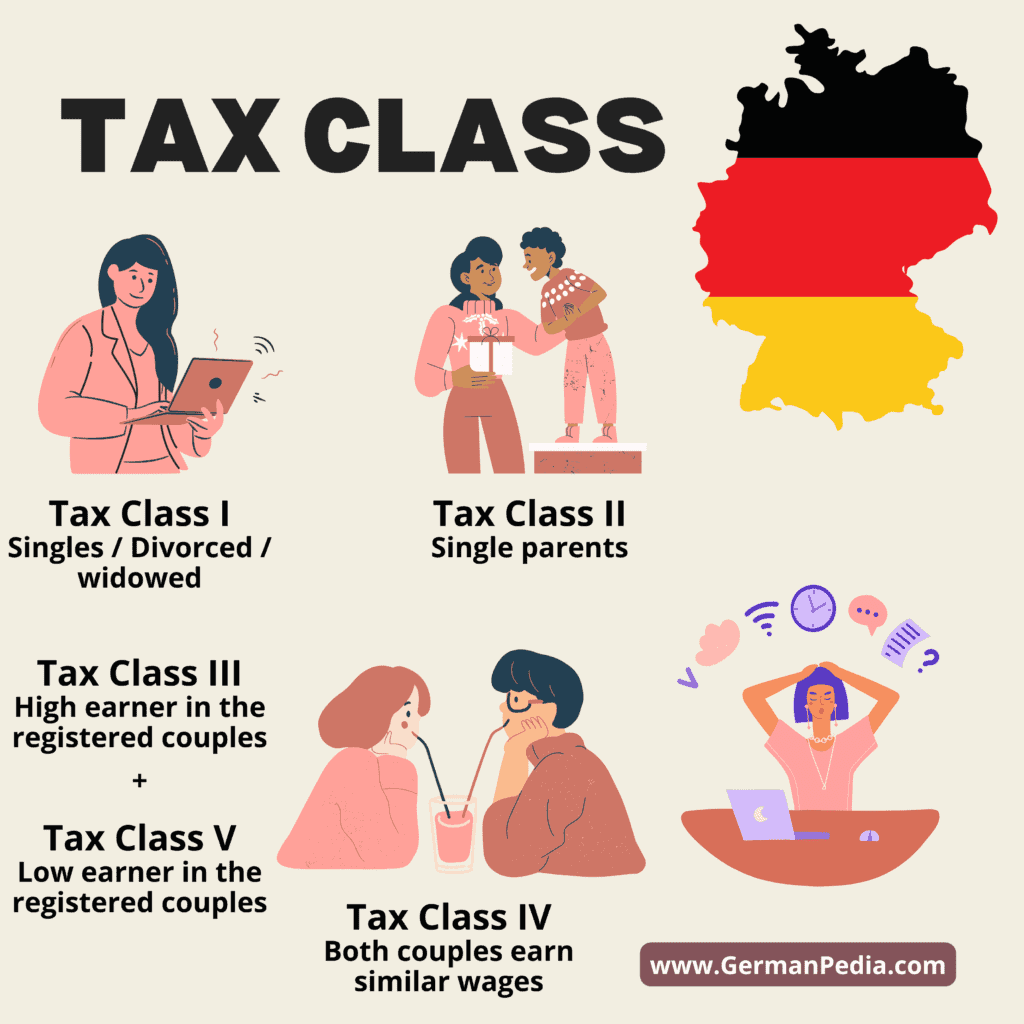
Tax class I (Steuerklasse 1 in German)
Tax class 1 applies to the following people.
- Single
- Divorced employees
- Widowed employees – but only from the second year after the spouse’s death.
- A non-german employee whose spouse lives outside the EU.
- An employee who is subject to limited income tax liability because they earn income in Germany but live abroad permanently.
Tax class II (Steuerklasse 2 in German)
All individuals listed in tax class 1 can opt for tax class II, provided they are single parents.
The prerequisite is that at least one child lives in your household for whom you receive a child allowance or child benefit.
Tax class III (Steuerklasse 3 in German)
Tax class 3 applies to married employees and registered civil partners. But, you must fulfill the following conditions to be eligible for this tax class.
- You and your partner both live in Germany.
- You do not live in different households permanently.
- Your spouse does not earn, or they are in tax bracket 5.
Tax class IV (Steuerklasse 4 in German)
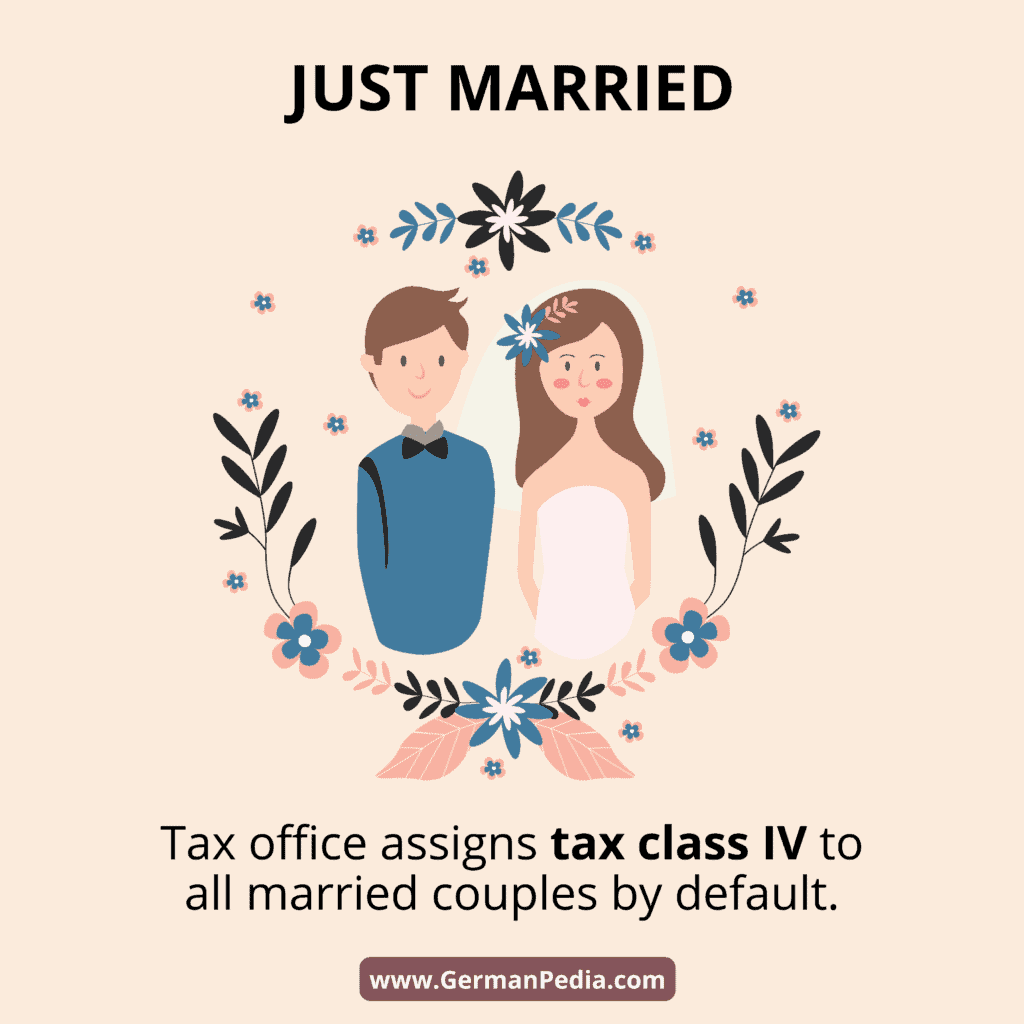
The tax office automatically assigns the newly married couples tax class IV irrespective of whether they both work or not. To be eligible for tax class IV, you and your spouse must live in Germany and not live in different households all the time.
The tax deduction is similar to that in tax class 1. Thus, tax class 4 makes sense if both partners earn almost the same income.
Cheatsheet to Save Taxes – Free Download

- Download the cheatsheet summarizing all the expenses you can deduct from the taxes.
- Maximize your tax savings by claiming expenses you don’t need proof of.
- Moved due to work, bought a new chair, repaired your rental apartment, etc. Claim all these expenses to save tax.
Tax class IV with factor (Steuerklasse 4 mit Faktor in German)
The option to select the tax class combination 4/4 with a factor has been available since 2010. The factoring technique ensures a fair distribution of the salary tax burden within a marriage or registered civil partnership.
However, filing an annual tax declaration is compulsory if you opt for tax class IV with factor. Moreover, you must apply to stay in this tax class combination every two years.
You can use online services to help you file and save income tax in Germany. We find Wundertax* and SteuerGo* among the best tax software out there.
If you have a complex tax return or filing it yourself makes you nervous, you should get advice from a tax consultant. Tax consultants are not cheap in Germany. Depending on your situation, they may cost between 800€ and 1500€.
However, a good tax consultant can save you a lot of money.
You can get a free quote from the tax consultant we recommend here. The tax advisor offers services in English.
Get a Free Quote From a Tax Advisor

- A tax advisor can help you file an income tax return,
- Change tax class,
- Get a tax residency certificate,
- Support in starting a business,
- Offer services in English
File Income Tax with Wundertax

- 34.99 € for filing a single income tax return
- Tips on deductible costs & plausibility check
- Try it out for free & only submit if you’re fully satisfied
- Also available in English
File Income Tax with SteuerGo

- 34.95 € for filing a single income tax return
- Easy to file and save tax.
- The tool is also available in English.
- Get tax-saving tips to maximize your tax return in the current and the following years.
Tax class V (Steuerklasse 5 in German)
If one spouse (the one with the higher income) requests to go to tax bracket 3, the other spouse gets the tax class 5.
In tax class 5, the tax office doesn’t consider any tax allowances. As a result, the spouse under tax class V ends up paying more tax.
Tax class VI (Steuerklasse 6 in German)
Employees who start a second or third job automatically end up in tax class VI. In tax class VI, one pays the most tax as the tax office considers no tax-free allowance.
But there is a silver lining. You can decide on which of your jobs tax class 6 should be applied.
You can read more about tax classes in our guide on “Tax Classes in Germany.”
What is the basic tax-free amount in Germany?
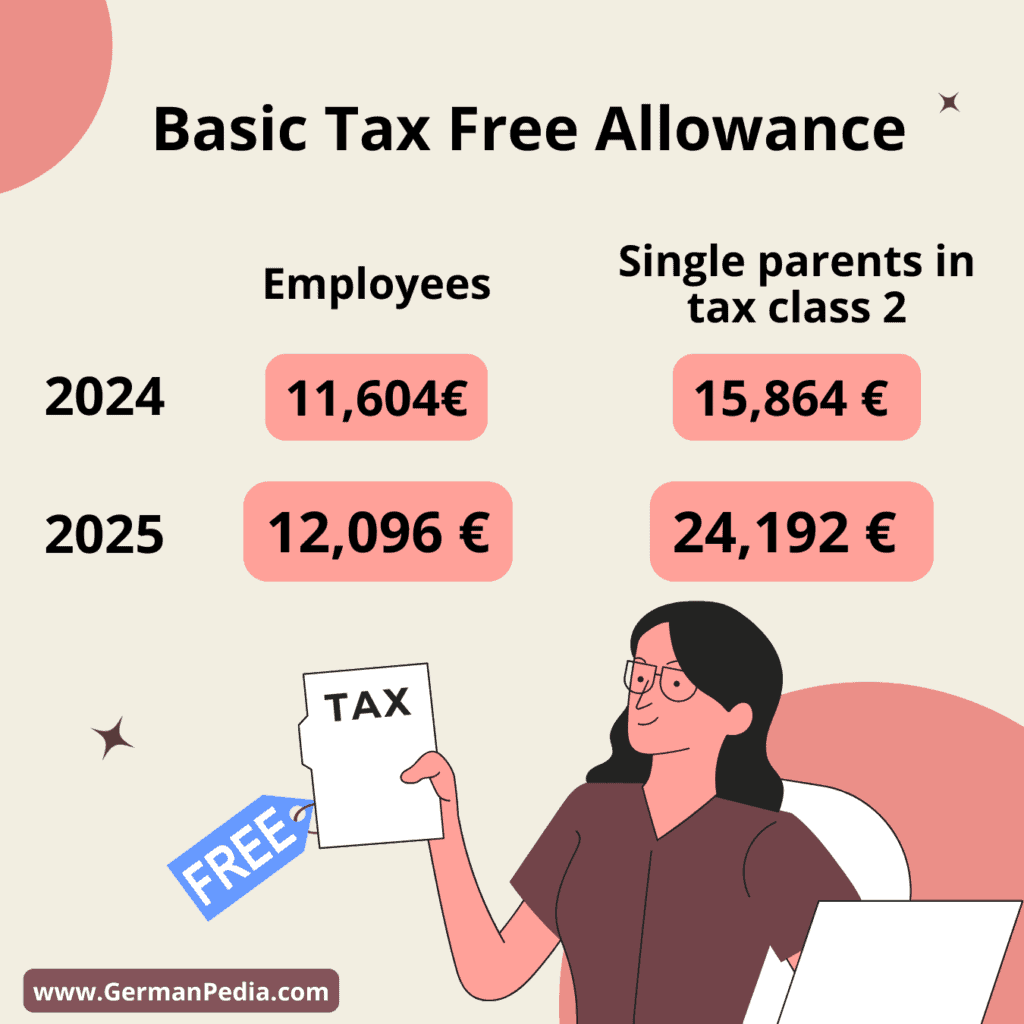
The basic tax-free allowance ensures that everyone’s minimum subsistence level remains tax-free.
| Basic Tax-Free Allowance | |
|---|---|
| For employees | 12,096€ (in 2025) and 11,784€ (in 2024) |
| For single parents in tax class 2 | Single parents get an additional allowance of 4,260€ (as of 2025) for the first child and 240€ additionally for each additional child on top of the basic tax allowance. |
Learn more about the allowances the German government offers to single parents in our guide on “tax allowances in Germany.”
What are the income tax rates in Germany?
Germany has progressive tax rates that range from 14% to 45%, depending on your earnings. You can read more about it here.
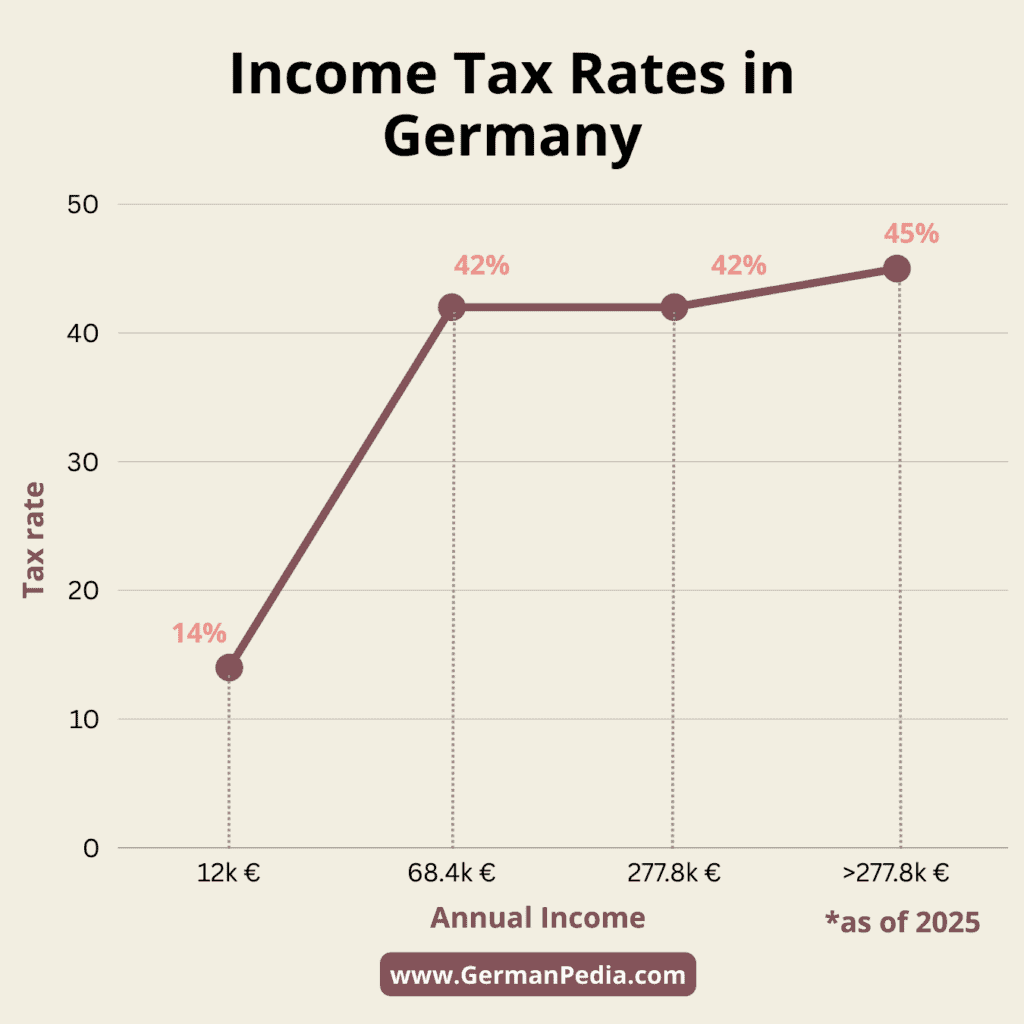
Most asked questions on changing tax class in Germany
Can I get the tax benefits retroactively?
Yes, the tax office considers the previous months of the year in which you applied for a tax class change.
Usually, it is marriage day. However, you cannot apply for a tax class change if your partner does not live in Germany.
You can only apply for a tax class change once your partner comes to Germany. Hence, in this case, the tax office calculates taxes retroactively based on the day your partner registers in Germany instead of the marriage date.
Is it worth changing tax classes?
Yes, in most cases, it’s worth changing your tax classes after marriage. But we suggest using the tax calculators to calculate the net income with different tax class combinations.
How often can I change my tax classes in Germany?
Since 2020, couples can change their tax classes multiple times a year. The restriction of changing tax classes once a year is no longer there.
Which life situations can trigger a tax class change?
Any marital status, health, or employment change can cause a tax class change. For example, marriage, divorce, death of partner, unemployment, retirement, parental leave, self-employed, etc.
You should consult a tax advisor regarding which tax class is best for you. Tax consultants in Germany are expensive. However, they can save you a lot of money.
You can book a call with the tax advisor we recommend here. They offer their services in English.
Get a Free Quote From a Tax Advisor

- A tax advisor can help you file an income tax return,
- Change tax class,
- Get a tax residency certificate,
- Support in starting a business,
- Offer services in English
How do I change my tax class after a divorce or separation?
As soon as a couple splits and starts living separately, the tax office assigns them tax class 1. However, both partners can keep their existing tax classes until the end of the year they are separated.
You can read more about it in our guide on “How does separation or divorce affect ex-partners’ tax classes and annual income tax?.”
Can I change my tax class after marriage if my partner lives outside Germany?
No, you cannot change tax class if your partner does not live in Germany.
But there is an exception if your partner lives in the EU or Switzerland. In this situation, you can change your tax class if you fulfill the following requirements.
- The employee (you) is a national of an EU or EEA country.
- The family residence where the spouse/life partner lives is in another EU or EEA country or Switzerland.
- At least 90% of the total income is subject to German income tax. The same applies if the income not subject to German income tax does not exceed 19,964€ in the calendar year.
More topics
- How to save taxes in Germany?
- Tax allowances and flat rates in Germany
- Tax ID and number
- Tax classes
- Capital gains tax
- Deduct relocation costs from taxes
- Types of taxes you pay in Germany
- How much money does the German government collect in the form of taxes?
- Is filing a voluntary tax return worth it?
- What income-related costs can you deduct from taxes in Germany?
- Avoid double taxation in Germany
- Do you pay tax on income from outside Germany?
- Deduct medical expenses from taxes in Germany
References
- https://www.bundesfinanzministerium.de/Content/DE/Standardartikel/Themen/Steuern/das-aendert-sich-2023.html
- https://www.finanztip.de/lohnsteuer-steuerklasse/
- https://taxsummaries.pwc.com/germany/individual/taxes-on-personal-income
- https://www.bundesfinanzministerium.de/Web/DE/Service/Apps_Rechner/Abgabenrechner/abgabenrechner.html
